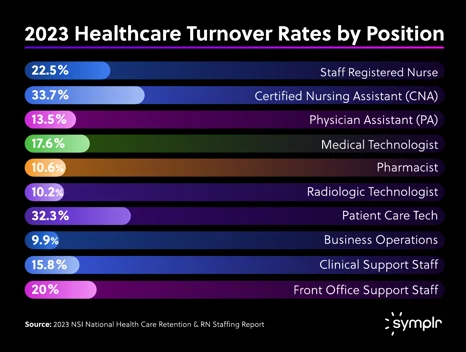 By Karissa Fuller, Managing Director & SVP, symplr
By Karissa Fuller, Managing Director & SVP, symplr
LinkedIn: Karissa Fuller
X: @symplr
According to symplr’s 2023 Compass Survey of health system leaders, workforce challenges are the top threat to healthcare organizations in the coming year. Demand for healthcare services has ramped up in recent years due to population growth and aging, while increasing numbers of healthcare professionals are leaving the industry due to burnout or reaching retirement age. As a result, today’s healthcare workforce is plagued with shortages and turnover, and many healthcare providers struggle to find and hire qualified candidates. In this blog, we’ll explore the reasons behind hard-to-fill healthcare roles and key strategies for finding and retaining healthcare talent.
The current state of healthcare staffing
One of the most significant challenges in healthcare recruiting is the shortage of skilled professionals. Today’s healthcare recruitment space is hypercompetitive, making it difficult for recruiters and sources to keep up. On average, healthcare recruiters have 61 open roles they are trying to fill at once. The average time to fill a position in healthcare is 49 days. By comparison, the average across industries in the United States is only 36 days.
The takeaway? The strategies healthcare organizations are using aren’t helping them find the elusive talent they need. Healthcare organizations will only be able to decrease time-to-fill without sacrificing quality care by moving from reactively filling roles to proactively sourcing quality talent. To do this effectively, you need to be sure your team has the right skills and is set up for efficiency.
At symplr, we realize that even the best healthcare recruiters can struggle if the right processes aren’t in place to support them. You can improve your time-to-fill even on the hardest-to-fill positions by optimizing your process and workflows and integrating modern techniques for sourcing the right candidates.
High demand, low supply: hard-to-staff healthcare roles
Typically, hard-to-fill positions in the healthcare sector include registered nurses, nurse practitioners, general practitioners, physical therapists, and psychiatrists. Other specialty areas facing staffing challenges include geriatrics, rheumatology, and various surgical specializations.
 These healthcare positions are often difficult to fill due to a variety of reasons, including shortages in qualified healthcare professionals, demanding workloads, and the substantial experience and specialization required for these roles. Additionally, these positions often include shift work which can impact work-life balance and be a deterrent for some qualified candidates. Time-to-fill problems are also driven by organizational workflow issues, lack of recruitment data, and lack of necessary technology to support modern recruiting methods.
These healthcare positions are often difficult to fill due to a variety of reasons, including shortages in qualified healthcare professionals, demanding workloads, and the substantial experience and specialization required for these roles. Additionally, these positions often include shift work which can impact work-life balance and be a deterrent for some qualified candidates. Time-to-fill problems are also driven by organizational workflow issues, lack of recruitment data, and lack of necessary technology to support modern recruiting methods.
Even the best hospitals with the best recruiters encounter time-to-fill challenges. Failing to take a strategic approach to talent management, including a focus on retention during the hiring process, puts health systems into a vicious cycle of employee turnover.
The impact of empty healthcare roles on patient care
Understaffing leads to longer wait times for patients to schedule necessary appointments, allowing conditions to potentially progress to the point where patients need emergency care. Providers also have less time to spend with each patient and deal with a heavier administrative burden as a result of understaffing, increasing the likelihood of missed/incorrect diagnoses and other medical errors. Data shows that many nurses and other healthcare providers already spend over half their day on administrative tasks like scheduling, data input, and payroll, leaving them with little time to spend with patients. With clinicians already strapped for time for direct patient care, understaffing and inability to fill open healthcare roles further exacerbates this issue.
Strategies for swift and high-quality staffing solutions
To attract and retain healthcare talent, we recommend a four-pronged approach:
- Leverage Technology: Many hospitals have too many systems that don’t communicate with each other and use recruitment technology that is missing the full set of modern features that job seekers expect. Healthcare organizations must utilize modern recruitment platforms to reach a broader audience.
- Establish a Talent Pipeline: Establish connections through conferences and networking events and keep them engaged by sending newsletters, webinars, event updates, and more. This helps to create a pipeline of interested and qualified candidates for future opportunities.
- Leverage Employee Referral Programs: Tap into the existing network of your workforce by offering incentives for employees who refer qualified candidates.
- Improve Candidates’ Experiences: Inefficient recruitment and interviewing processes may lead candidates to look elsewhere. To keep candidates on the line, maintain prompt and transparent communication throughout the hiring process and cut out any extraneous steps or interview stages.
By integrating these approaches, healthcare organizations can create a comprehensive strategy to attract and retain the best talent.
symplr’s innovative talent sourcing solutions
While many hospitals look at success as filling empty seats when it comes to their recruitment efforts, at symplr, we know that quality-of-hire, retention, and tenure tell the full story of how talent acquisition helps improve an organization. We also know that recruiting is both an art and a science. We give you the tools you need to understand what tactics are working with talent analytics and even to predict a candidate’s performance, so you can improve your time-to-fill.
symplr’s solutions for talent management, sourcing, and recruiting help health systems attract, hire, and retain healthcare talent:
- Talent Sourcing: This tool helps health systems save time on sourcing and improve hiring efficiency. You can schedule automatic searches of multiple sources to build an aggregated pool of candidates and to get ahead of your recruiting challenges.
- Talent Networks: Save time by aggregating all sourced talent into a single place, where you can then search and communicate with them. Talent Networks also give potential candidates something to sign up for when there isn’t a position that matches their skills.
- Talent Analytics: Drive better visibility, more intelligent automation, and faster time-to-hire with actionable analytics to deliver predictable hiring results for your organization.
- Job Distribution: Increase the effectiveness of your job advertising by using a centralized portal to manage your job postings across a wide range of job boards, social media platforms, and agency partners. Automate the distribution of job postings to hundreds of locations, including those specific to your industry.
- Applicant Tracking: Our modern applicant tracking system (ATS) helps you automate requisition workflows, find qualified applicants quickly, and enable collaboration between recruiters and hiring managers.
- Candidate Relationship Management: Track relationships with potential hires and use our email software to communicate with your Talent Network, either through targeted audiences or through your entire list. Set up automatic campaigns for efficiency.
- Behavioral Assessments: Our scientifically backed behavioral assessments provide real data to help inform your hiring decisions. These hospital-specific assessments measure candidates’ behavioral competencies, which is key for performance in an organization like yours.
- Structured Interview Guides: Based on the candidate’s assessment scores, this guide arms the interviewer with questions to probe any low scores in the assessment. The behavioral questions help ensure the applicant aligns with the job requirements and is a cultural fit.
- Automated Reference Checking: These confidential online surveys track “digital fingerprints” for integrity. Additionally, candidate involvement in the process improves completion rates and cuts down on time associated with this common task.
- Onboarding: symplr’s onboarding technology helps you automate the entire process. It integrates with your HR and background check systems, sending job offers and timely candidate communications.
symplr knows that technology should be making your work easier and reduce your time-to-fill, rather than add to it. That is why we offer an integrated platform solution tailored specifically to hiring, keeping, and growing a quality healthcare workforce. With symplr, healthcare organizations can optimize the recruitment and hiring processes and reduce the time it takes to fill hard-to-fill healthcare roles.
This article was originally published on the symplr blog and is republished here with permission.
